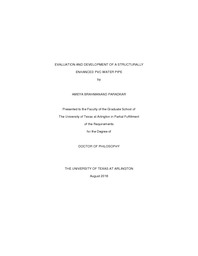| dc.description.abstract | Many U.S. utilities rely upon iron pipe to deliver water through their distribution network. It has only been in the past 50 years that other products have penetrated into the water utilities' pipeline. The industry has turned to various cementitious and plastic materials largely to overcome aggressive soil and water that can be corrosive to metallic pipes. This dissertation will discuss a new pipe material called iPVC pipe manufactured by Pyunghwa Pipe Industry Inc. (PPI), South Korea. The iPVC pipe was evaluated by a series of selective testing on the pipe, including impact, stiffness, tensile, short-term hydrostatic burst pressure, fatigue and bedding tests as well as pilot installation and operation of the pipe as part of an active system. The testing described here was funded by American Water (AW), a water utility company based in Voorhees, NJ through a grant from Water Research Foundation (WRF), Denver, CO.
The iPVC pipe parameters such as modulus of elasticity, pipe stiffness, design fatigue life, tensile strength, short-term burst pressure, impact strength, hoop stress and deflections of iPVC pipe are computed based on the tests performed. The iPVC pipe parameters such as modulus of elasticity, pipe stiffness, design fatigue life, tensile strength, short-term burst pressure, impact strength, hoop stress and deflections of iPVC pipe are computed based on the tests performed. The iPVC pipe properties exceeds the American Water Works Association (AWWA) minimum standards requirements. The results of iPVC pipe for hydrostatic short-term burst pressure, impact strength, pipe stiffness, and tensile strenght of iPVC pipe are higher than those required by AWWA standards. The average hydrostatic short-term burst pressure recorded was 1,042 psi (40% higher than AWWA standards requirements), average impact strength recorded was 1,200 foot-pounds at 73 °F (12 times higher) and 1,080 foot-pounds at 32 °F (10 times higher), average pipe stiffness recorded was 479 psi (32% higher) and average tensile strength recorded was 7,930 psi (13% higher).
The fatigue design life for 8 in. DR 18 iPVC pipe is 125 years considering only the surge pressure experienced by the pipe. A finite element analyses is performed to evaluate the deflection of iPVC pipe under earth load and earth plus live (truck) load simulations. The results from finite element analyses are compared with theoretical values of deflection as well as the experimental value obtained from the bedding test. The maximum deflection experienced by the iPVC pipe is less than the AWWA maximum allowable deflection of 5% for 8 in. DR 18 PVC pipe. | |


